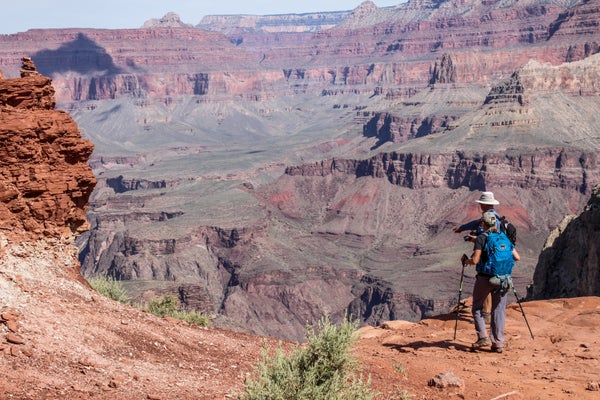CLIMATEWIRE | Grand Canyon National Park reported its first heat-related fatality of the summer in July, when a 57-year-old woman died while attempting an 8-mile hike in the remote Tuweep area of the park. Temperatures there soared to well over 100 degrees Fahrenheit the day the woman died, and temperatures on nearby trails are known to top 120 degrees.
These kinds of incidents will become more common as the climate continues to warm, scientists say. A new study published last week in the journal PLOS One finds that heat-related illness and deaths are likely to soar at Grand Canyon National Park in the coming decades as temperatures rise.
The number of weekly heat illnesses could spike by anywhere from 29 to 137 percent above their 2004-2009 levels by the end of this century depending on temperature increases, according to a research team led by National Park Service epidemiologist Danielle Buttke. Heat illness includes adverse reactions such as headaches, vomiting, muscle cramps and death.
On supporting science journalism
If you're enjoying this article, consider supporting our award-winning journalism by subscribing. By purchasing a subscription you are helping to ensure the future of impactful stories about the discoveries and ideas shaping our world today.
Grand Canyon is one of the nation’s most popular national parks — it was the second-most visited national park in 2022. The 1.2-million-acre park in northern Arizona typically sees its highest number of visitors during the warmest months of the year.
Summer temperatures in the inner canyon, at the bottom of the Grand Canyon, regularly reach 120 degrees. And because the inner canyon is filled with dark-colored stones, which absorb heat, the air often feels even hotter — as high as 130 or even 140 degrees, said park spokesperson Joelle Baird.
Between 2004 and 2009, when the park had more than 4.3 million visitors each year, there were roughly 77 illnesses during the annual six-month peak season from April through September, the researchers found.
The number could increase to between 138 and 254 heat illnesses during peak season under extreme climate change that sees global temperatures rise by nearly 5 degrees Celsius by the end of the century, researchers found.
Although that climate scenario is unlikely, the actual number of illnesses will probably be higher because the projection assumes no increase in the number of visitors through 2100.
Heat illness in the Grand Canyon is more likely to occur in the early and late parts of peak season, probably due to human behavior, the researchers found. Cooler temperatures in the spring and early fall mean that visitors are sometimes less prepared for extreme heat during these seasons. They might choose more strenuous hikes or carry less water than they would in the summer.
The research team used records of the number of Grand Canyon visitors, recorded heat illnesses and temperature, humidity and other climate variables to build a model estimating the heat illness rate.
They applied the model to two hypothetical future warming scenarios. One scenario assumes moderate levels of future climate change, around 3 degrees Celsius of global warming by the end of this century. That’s similar to the amount of global warming scientists predict will occur if world leaders don’t swiftly step up their climate action plans within the next few years.
The other scenario assumes much more extreme, if relatively unlikely, future warming.
The analysis found that the rate of heat-related illnesses soars in both scenarios, increasing more with greater levels of future warming.
Advising visitors about safe hiking and the dangers of extreme heat is one of the park’s primary strategies for protecting the public, said Baird, the park spokesperson. The park’s website is continuously updated with warnings about extreme temperatures, and park staff post flyers at trailheads when excessive heat warnings are in effect.
“A lot of it is increasing awareness that it is very hot here even before people step foot on the trail,” Baird said.
If visitors still choose to hike during extreme heat events, park staff advise that they avoid the hottest hours — typically between 10 a.m. and 4 p.m. — and carry plenty of water and food.
Water stations are located along Bright Angel Trail, the park’s most popular hiking trail, Baird noted. And rangers are typically roaming the trails in case hikers need help. But cellphone service can be spotty in some areas of the park.
The park is testing new public information campaigns as temperatures rise, including posting QR codes at the heads of some of their busiest trails, where cellphone service is usually available.
“Instead of posting a flyer, say, every time there’s an excessive heat warning, they can use that QR code to go to our website and know firsthand what they should be prepared for when hiking on that trail,” Baird said.
Reprinted from E&E News with permission from POLITICO, LLC. Copyright 2023. E&E News provides essential news for energy and environment professionals.
